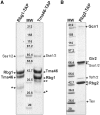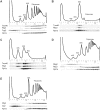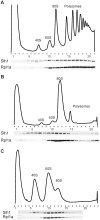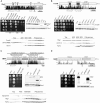The highly conserved eukaryotic DRG factors are required for efficient translation in a manner redundant with the putative RNA helicase Slh1
- PMID: 21076151
- PMCID: PMC3064805
- DOI: 10.1093/nar/gkq898
The highly conserved eukaryotic DRG factors are required for efficient translation in a manner redundant with the putative RNA helicase Slh1
Abstract
Eukaryotic and archaeal DRG factors are highly conserved proteins with characteristic GTPase motifs. This suggests their implication in a central biological process, which has so far escaped detection. We show here that the two Saccharomyces cerevisiae DRGs form distinct complexes, RBG1 and RBG2, and that the former co-fractionate with translating ribosomes. A genetic screen for triple synthetic interaction demonstrates that yeast DRGs have redundant function with Slh1, a putative RNA helicase also associating with translating ribosomes. Translation and cell growth are severely impaired in a triple mutant lacking both yeast DRGs and Slh1, but not in double mutants. This new genetic assay allowed us to characterize the roles of conserved motifs present in these proteins for efficient translation and/or association with ribosomes. Altogether, our results demonstrate for the first time a direct role of the highly conserved DRG factors in translation and indicate that this function is redundantly shared by three factors. Furthermore, our data suggest that important cellular processes are highly buffered against external perturbation and, consequently, that redundantly acting factors may escape detection in current high-throughput binary genetic interaction screens.
Figures






Similar articles
-
Conserved heterodimeric GTPase Rbg1/Tma46 promotes efficient translation in eukaryotic cells.Cell Rep. 2021 Oct 26;37(4):109877. doi: 10.1016/j.celrep.2021.109877. Cell Rep. 2021. PMID: 34706231 Free PMC article.
-
Asc1, Hel2, and Slh1 couple translation arrest to nascent chain degradation.RNA. 2017 May;23(5):798-810. doi: 10.1261/rna.060897.117. Epub 2017 Feb 21. RNA. 2017. PMID: 28223409 Free PMC article.
-
Medulloblastoma-associated mutations in the DEAD-box RNA helicase DDX3X/DED1 cause specific defects in translation.J Biol Chem. 2021 Jan-Jun;296:100296. doi: 10.1016/j.jbc.2021.100296. Epub 2021 Jan 16. J Biol Chem. 2021. PMID: 33460649 Free PMC article.
-
The Ded1/DDX3 subfamily of DEAD-box RNA helicases.Crit Rev Biochem Mol Biol. 2014 Jul-Aug;49(4):343-60. doi: 10.3109/10409238.2014.931339. Crit Rev Biochem Mol Biol. 2014. PMID: 25039764 Review.
-
Developmentally regulated GTPases: structure, function and roles in disease.Cell Mol Life Sci. 2021 Dec;78(23):7219-7235. doi: 10.1007/s00018-021-03961-0. Epub 2021 Oct 19. Cell Mol Life Sci. 2021. PMID: 34664086 Free PMC article. Review.
Cited by
-
Conserved heterodimeric GTPase Rbg1/Tma46 promotes efficient translation in eukaryotic cells.Cell Rep. 2021 Oct 26;37(4):109877. doi: 10.1016/j.celrep.2021.109877. Cell Rep. 2021. PMID: 34706231 Free PMC article.
-
Elevated ZC3H15 increases HCC growth and predicts poor survival after surgical resection.Oncotarget. 2016 Jun 14;7(24):37238-37249. doi: 10.18632/oncotarget.9361. Oncotarget. 2016. PMID: 27191988 Free PMC article.
-
Ribo-Seq and RNA-Seq of TMA46 ( DFRP1) and GIR2 ( DFRP2) knockout yeast strains.F1000Res. 2021 Nov 16;10:1162. doi: 10.12688/f1000research.74727.1. eCollection 2021. F1000Res. 2021. PMID: 34900236 Free PMC article.
-
A spatial long-read approach at near-single-cell resolution reveals developmental regulation of splicing and polyadenylation sites in distinct cortical layers and cell types.bioRxiv [Preprint]. 2025 Jun 10:2025.06.10.658877. doi: 10.1101/2025.06.10.658877. bioRxiv. 2025. Update in: Nat Commun. 2025 Aug 29;16(1):8093. doi: 10.1038/s41467-025-63301-9. PMID: 40661641 Free PMC article. Updated. Preprint.
-
Structure of Gcn1 bound to stalled and colliding 80S ribosomes.Proc Natl Acad Sci U S A. 2021 Apr 6;118(14):e2022756118. doi: 10.1073/pnas.2022756118. Proc Natl Acad Sci U S A. 2021. PMID: 33790014 Free PMC article.
References
-
- Leipe DD, Wolf YI, Koonin EV, Aravind L. Classification and evolution of P-loop GTPases and related ATPases. J. Mol. Biol. 2002;317:41–72. - PubMed
-
- Caldon CE, March PE. Function of the universally conserved bacterial GTPases. Curr. Opin. Microbiol. 2003;6:135–139. - PubMed
-
- Li B, Trueb B. DRG represents a family of two closely related GTP-binding proteins. Biochim. Biophys. Acta. 2000;1491:196–204. - PubMed
-
- O'Connell A, Robin G, Kobe B, Botella JR. Biochemical characterization of Arabidopsis developmentally regulated G-proteins (DRGs) Protein Expr. Purif. 2009;67:88–95. - PubMed
-
- Sazuka T, Tomooka Y, Ikawa Y, Noda M, Kumar S. DRG: a novel developmentally regulated GTP-binding protein. Biochem. Biophys. Res. Commun. 1992;189:363–370. - PubMed
Publication types
MeSH terms
Substances
LinkOut - more resources
Full Text Sources
Molecular Biology Databases

